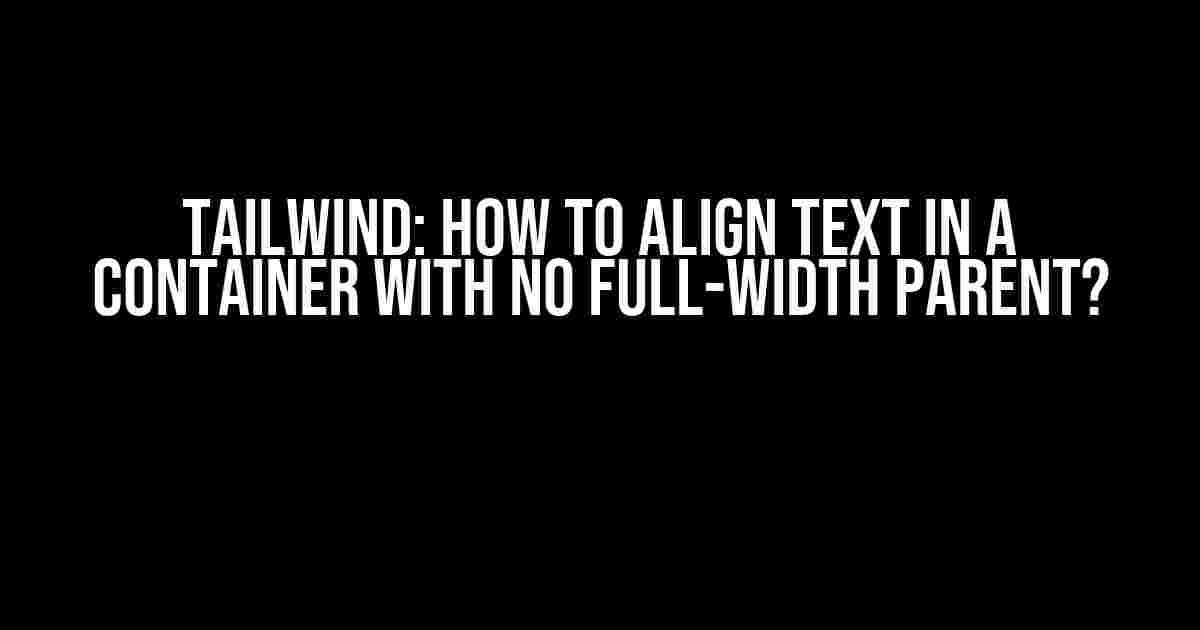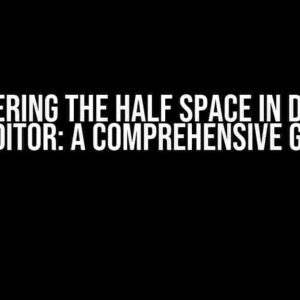Are you tired of struggling to align text in a container that doesn’t take up the full width of its parent? Well, you’re in luck because Tailwind CSS has got you covered! In this article, we’ll explore the different ways to align text in a container with no full-width parent using Tailwind’s utility-first approach.
Understanding the Problem
Before we dive into the solutions, let’s take a step back and understand the problem we’re trying to solve. When we create a container element with a fixed width, and place it inside a parent element that doesn’t take up the full width of the screen, our text alignment can get wonky.
<div class="container mx-auto" style="width: 500px">
<p>This text is not aligned properly</p>
</div>In the above example, the container has a fixed width of 500px, and we’re trying to align the text inside it. However, since the parent element (in this case, the body) takes up the full width of the screen, our text alignment gets thrown off.
Method 1: Using `text-align` Utilities
Tailwind provides a range of `text-align` utilities that allow us to align text horizontally within an element. We can use these utilities to align our text in the container.
<div class="container mx-auto" style="width: 500px">
<p class="text-center">This text is now centered</p>
</div>In the above example, we’ve added the `text-center` utility to the paragraph element, which centers the text horizontally. We can also use `text-left` or `text-right` to align the text to the left or right, respectively.
Method 2: Using Flexbox
Another way to align text in a container with no full-width parent is to use flexbox. Tailwind provides a range of flexbox utilities that allow us to control the layout of our elements.
<div class="container mx-auto" style="width: 500px">
<p class="flex justify-center">This text is now centered</p>
</div>In the above example, we’ve added the `flex` and `justify-center` utilities to the paragraph element. This tells Tailwind to treat the paragraph as a flex container, and center the text horizontally using flexbox.
Method 3: Using Grid
If you’re working with a more complex layout, you might want to use grid to align your text. Tailwind provides a range of grid utilities that allow us to control the layout of our elements.
<div class="container mx-auto" style="width: 500px">
<p class="grid justify-items-center">This text is now centered</p>
</div>In the above example, we’ve added the `grid` and `justify-items-center` utilities to the paragraph element. This tells Tailwind to treat the paragraph as a grid container, and center the text horizontally using grid.
Method 4: Using Margin and Padding
Another way to align text in a container with no full-width parent is to use margin and padding utilities. Tailwind provides a range of margin and padding utilities that allow us to control the spacing of our elements.
<div class="container mx-auto" style="width: 500px">
<p class="mx-auto px-4">This text is now aligned properly</p>
</div>In the above example, we’ve added the `mx-auto` utility to center the paragraph element horizontally, and the `px-4` utility to add padding to the left and right sides of the element. This aligns the text properly within the container.
Method 5: Using Custom CSS
Finally, if you’re working with a more complex layout, you might need to write custom CSS to align your text. Tailwind provides a range of configuration options that allow us to customize the framework to our needs.
<div class="container mx-auto" style="width: 500px">
<p class="grid grid-cols-align-text justify-items-center">This text is now centered</p>
</div>In the above example, we’ve added a custom grid template column definition to our `tailwind.config.js` file, and used it to center the text within the container.
Conclusion
Aligning text in a container with no full-width parent can be a challenge, but Tailwind provides a range of utilities that make it easy to achieve. Whether you’re using `text-align` utilities, flexbox, grid, margin and padding, or custom CSS, there’s a solution that’s right for you.
By following the methods outlined in this article, you’ll be able to align your text with ease, and create beautiful, responsive layouts that delight your users.
| Method | Description |
|---|---|
| Using `text-align` Utilities | Use `text-align` utilities to align text horizontally within an element. |
| Using Flexbox | Use flexbox utilities to control the layout of our elements and align text horizontally. |
| Using Grid | Use grid utilities to control the layout of our elements and align text horizontally. |
| Using Margin and Padding | Use margin and padding utilities to control the spacing of our elements and align text horizontally. |
| Using Custom CSS | Write custom CSS to align text horizontally within an element. |
FAQs
-
Q: What is the best method to align text in a container with no full-width parent?
A: The best method depends on your specific use case. If you’re working with a simple layout, using `text-align` utilities or margin and padding utilities might be the easiest solution. If you’re working with a more complex layout, using flexbox or grid might be a better option.
-
Q: Can I use multiple methods to align text in a container with no full-width parent?
A: Yes, you can use multiple methods to align text in a container with no full-width parent. For example, you can use `text-align` utilities in combination with flexbox or grid utilities to achieve the desired layout.
-
Q: Do I need to write custom CSS to align text in a container with no full-width parent?
A: No, you don’t need to write custom CSS to align text in a container with no full-width parent. Tailwind provides a range of utilities that make it easy to align text without writing custom CSS. However, if you’re working with a more complex layout, you might need to write custom CSS to achieve the desired result.
By following the methods outlined in this article, you’ll be able to align text in a container with no full-width parent with ease. Remember to choose the method that best fits your specific use case, and don’t be afraid to experiment with different approaches until you achieve the desired result.
Here are the 5 Questions and Answers about “Tailwind: How to align text in a container with no-full-width parent”:
Frequently Asked Question
Get clarity on aligning text in containers with no-full-width parents using Tailwind!
How do I align text in a container that doesn’t take up the full width of its parent?
You can use the `text-center` or `text-left` classes in Tailwind to align text within a container that doesn’t take up the full width of its parent. For example, `
` would center the text within the container.
What if I want to align text to the right side of the container?
Easy peasy! Just use the `text-right` class in Tailwind, like this: `
`. This will align the text to the right side of the container.
Can I use flexbox to align text in a container with no-full-width parent?
Yes, you can use flexbox to align text in a container with no-full-width parent. Tailwind provides a range of flexbox utility classes, such as `justify-center` or `justify-between`, that can help you achieve this. For example, `
` would center the text horizontally within the container.
How do I vertically align text in a container with no-full-width parent?
To vertically align text in a container with no-full-width parent, you can use the `items-center` class in Tailwind, like this: `
`. This will center the text vertically within the container.
Can I use Tailwind’s grid system to align text in a container with no-full-width parent?
Yes, you can use Tailwind’s grid system to align text in a container with no-full-width parent. For example, `
` would center the text both horizontally and vertically within the container.


